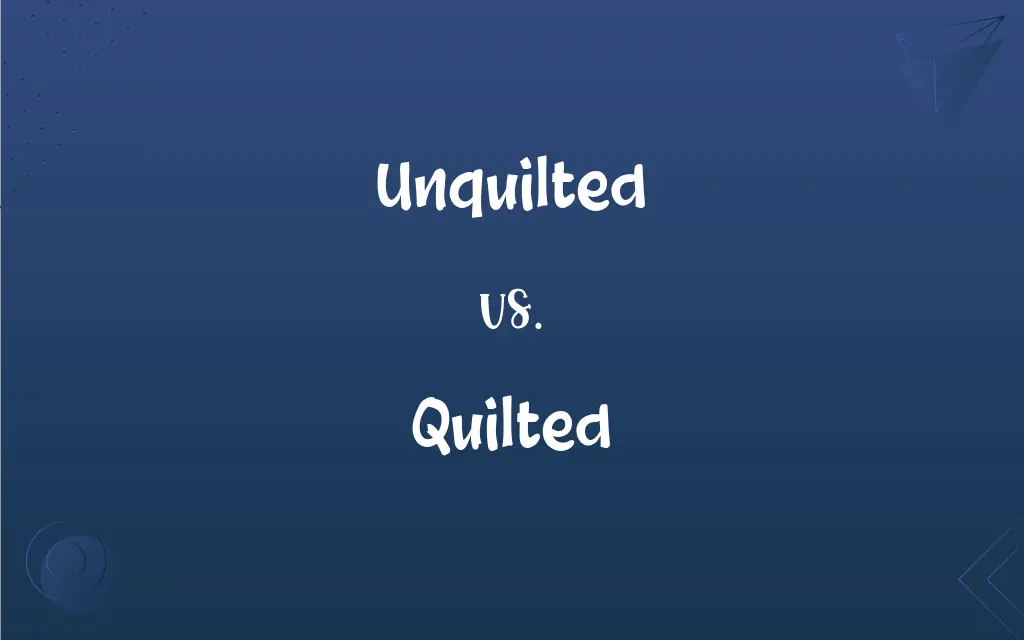Unquilted vs. Quilted: What's the Difference?
Edited by Aimie Carlson || By Harlon Moss || Updated on February 5, 2024
Unquilted refers to fabric or material without stitching layers together; quilted means fabric layers are stitched together for texture or insulation.

Key Differences
In terms of construction, unquilted materials are single layers of fabric without any additional layers stitched together. On the other hand, quilted materials consist of two or more layers of fabric, typically with a layer of padding or batting in between, that are stitched together to create patterns or designs. This fundamental difference affects the texture, appearance, and utility of the fabric.
Unquilted fabrics are generally lighter and more flexible, making them suitable for a wide range of applications that require a soft, pliable material. Quilted fabrics, with their multiple layers, offer increased warmth and cushioning, making them ideal for colder weather clothing, bedding, and upholstery. The quilting process adds bulk and structure, which can enhance the durability and aesthetic appeal of the material.
From a functional perspective, unquilted materials are often used in applications where insulation and thickness are not required. They are preferred for their simplicity and ease of maintenance. Quilted materials, with their enhanced insulative properties, are sought after for products that benefit from added warmth, such as jackets, blankets, and sleeping bags. The quilting also adds a decorative element to the material, allowing for creative designs and textures.
In terms of aesthetic and design possibilities, unquilted fabrics offer a smooth, uninterrupted surface that can be printed or dyed in various colors and patterns. Quilted materials, however, provide a three-dimensional texture that can add depth and interest to the design. The patterns created by the stitching can range from simple to complex, offering unique design opportunities.
The choice between unquilted and quilted materials often depends on the specific requirements of the project or product. While unquilted materials are versatile and widely used in various applications, quilted materials are chosen for their specific benefits of warmth, cushioning, and aesthetic appeal. Each has its place in the world of textiles, serving different needs and preferences.
ADVERTISEMENT
Comparison Chart
Construction
Single layer of fabric
Two or more layers of fabric stitched together
Weight
Lighter
Heavier due to additional layers
Flexibility
More flexible
Less flexible due to the thickness of layers
Insulation
Offers less insulation
Provides better insulation
Aesthetic
Smooth, uniform surface
Textured surface with patterns
ADVERTISEMENT
Unquilted and Quilted Definitions
Unquilted
Unquilted refers to a single layer of fabric without any stitching combining it with other layers.
The unquilted cotton dress was perfect for the summer breeze.
Quilted
Quilted items feature patterns or designs stitched through multiple layers for texture and decoration.
Her quilted handbag was both stylish and sturdy.
Unquilted
Unquilted materials are those not reinforced by stitching to create a padded effect.
She chose an unquilted jacket for its sleek and lightweight design.
Quilted
Quilted materials offer enhanced insulation and cushioning due to their layered construction.
He wore a quilted jacket to stay warm on his winter hike.
Unquilted
Unquilted items lack the layering and stitching that add bulk and insulation.
His unquilted vest was stylish but not warm enough for winter.
Quilted
Quilted fabrics are made by stitching together two or more layers of material, often with padding in between.
The quilted blanket provided extra warmth during the cold nights.
Unquilted
Unquilted fabrics are simple, without the added texture or pattern stitching provides.
The curtains were made of unquilted silk, giving the room a smooth, elegant look.
Quilted
Quilted denotes the technique of sewing layers together in a patterned manner to add depth and interest.
The quilted bedspread featured intricate designs, making it the centerpiece of the bedroom.
Unquilted
Unquilted denotes materials that are kept in their original, unlayered state without added texture.
The unquilted linen tablecloth had a natural, understated elegance.
Quilted
Quilted fabrics are characterized by their raised, textured patterns created by stitching.
The quilted upholstery added a luxurious touch to the living room sofa.
Unquilted
Not quilted.
Quilted
A coverlet or blanket made of two layers of fabric with a layer of cotton, wool, feathers, or down in between, all stitched firmly together, usually in a decorative design.
Quilted
A thick protective cover similar to or suggestive of a quilt.
FAQs
Are quilted fabrics always heavy?
Quilted fabrics tend to be heavier than unquilted due to the additional layers, but the weight varies depending on the materials used.
What is quilted fabric?
Fabric composed of multiple layers stitched together, often including a padded middle layer.
What are common uses for quilted fabric?
Quilted fabric is used in jackets, bedding, upholstery, and other items needing warmth or cushioning.
What is unquilted fabric?
Fabric that remains as a single layer without added stitching for layers or texture.
Can unquilted fabrics be used for insulation?
While less insulative than quilted, unquilted fabrics can provide minimal insulation.
Is unquilted material suitable for outdoor clothing?
Unquilted material can be used for lightweight outdoor clothing but may not provide sufficient warmth alone.
Do unquilted fabrics cost less than quilted?
Generally, unquilted fabrics are less expensive due to simpler construction, but costs vary by material quality.
Is quilting purely decorative?
Quilting adds decorative texture and patterns but also serves functional purposes like insulation and durability.
How do quilted and unquilted fabrics compare in weight?
Quilted fabrics are heavier due to the additional layers and padding.
What are the environmental impacts of quilting?
Quilting can increase material use and production time, potentially affecting environmental sustainability.
How does quilting affect the durability of fabric?
Quilting can increase fabric durability by reinforcing the material with additional layers and stitching.
How does quilting impact fabric flexibility?
Quilting reduces fabric flexibility by adding layers and stitching them together.
Can unquilted fabrics be quilted later?
Yes, unquilted fabrics can be quilted by adding layers and stitching through them.
Can any fabric be quilted?
Most fabrics can be quilted, but the choice of material affects the final product's look and feel.
Are quilted materials always warm?
Quilted materials are generally warmer than unquilted due to their insulative layers.
What is the aesthetic appeal of quilted vs. unquilted fabrics?
Quilted fabrics offer a textured, dimensional look, while unquilted fabrics provide a smooth, uniform appearance.
Is there a trend towards using quilted or unquilted fabrics in fashion?
Trends vary, with both quilted and unquilted fabrics being popular for different applications and styles.
What distinguishes quilted from unquilted in terms of care?
Quilted items may require special care due to their layers, while unquilted fabrics are often easier to maintain.
Can unquilted fabric be used for upholstery?
Yes, but quilted fabric is often chosen for added texture and comfort.
How does the choice between quilted and unquilted affect manufacturing costs?
Quilting involves more complex production processes, often leading to higher manufacturing costs compared to unquilted fabrics.
About Author
Written by
Harlon MossHarlon is a seasoned quality moderator and accomplished content writer for Difference Wiki. An alumnus of the prestigious University of California, he earned his degree in Computer Science. Leveraging his academic background, Harlon brings a meticulous and informed perspective to his work, ensuring content accuracy and excellence.
Edited by
Aimie CarlsonAimie Carlson, holding a master's degree in English literature, is a fervent English language enthusiast. She lends her writing talents to Difference Wiki, a prominent website that specializes in comparisons, offering readers insightful analyses that both captivate and inform.
































































